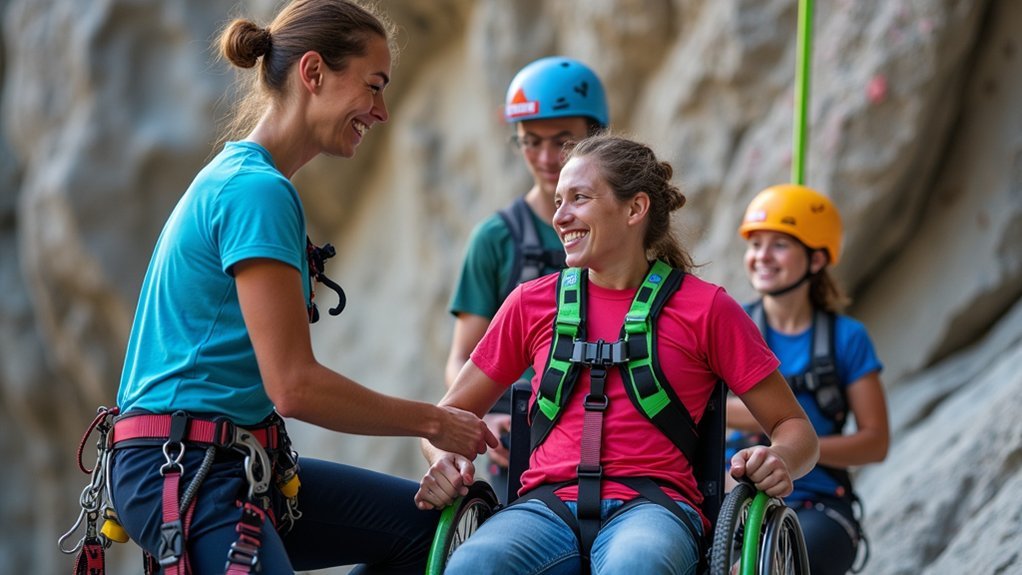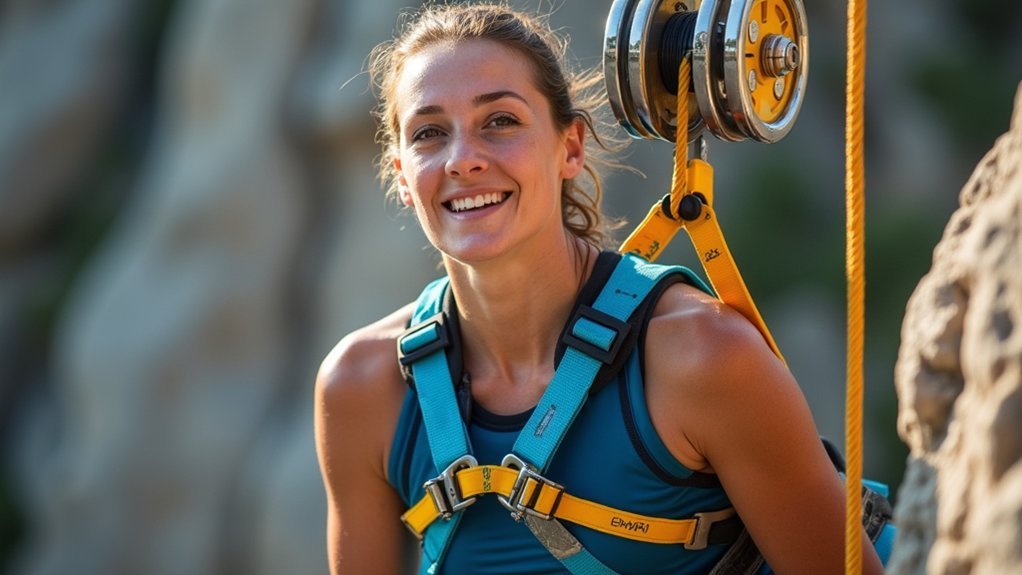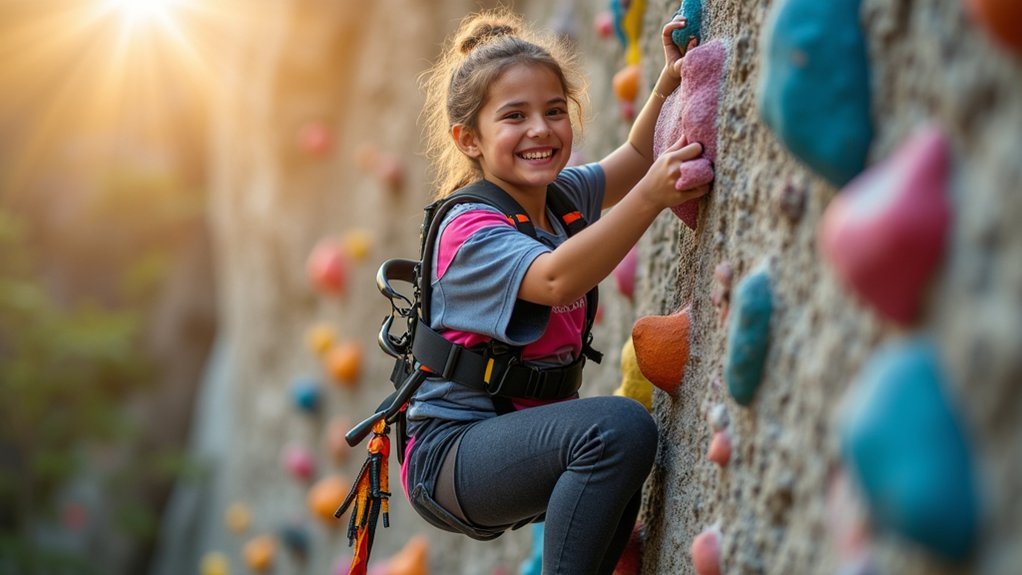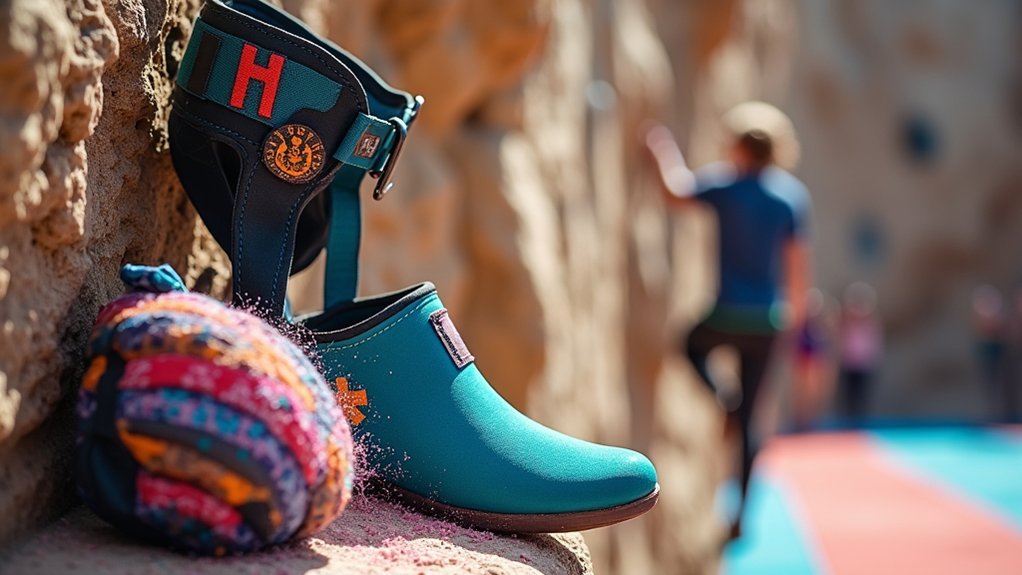Essential adaptive climbing gear for special needs athletes includes the Easy Seat Harness ($479.95) for comfort and stability, the Arc Harness ($579.95) with dual-point security, and the Wellman Pull Up Bar ($499.95) for enhanced control. Mechanical advantage systems reduce effort during ascents, while custom footwear like the Evolv Eldo Z ($50) and Evolv Adaptive Foot ($200) improve grip and integration. These specialized tools create accessible climbing experiences for all abilities. Discover how these innovations transform limitations into new climbing possibilities.
Top Adaptive Climbing Gear for Special Needs Athletes

When athletes with special needs pursue climbing, they require equipment designed specifically for their unique abilities. The Easy Seat Harness ($479.95) offers exceptional comfort and support, accommodating various physical abilities during adaptive climbing sessions.
Specialized adaptive equipment transforms climbing into an accessible adventure for athletes with diverse physical abilities.
For those seeking enhanced stability, the Arc Harness (starting at $579.95) provides adjustable features that securely fit different body types.
You’ll find the Wellman Pull Up Bar ($499.95) particularly valuable as it’s compatible with any adaptive harness, giving you better ascent control.
Don’t overlook the Adaptive Leg Loops with their wider straps and extra padding to protect your skin during climbs.
For quadriplegic climbers, the innovative HighRoller wheelchair enables conquering challenging routes that were previously inaccessible, demonstrating how far adaptive climbing equipment has evolved.
Specialized Harness Systems for Different Mobility Needs
Choosing the right harness system can make all the difference for climbers with mobility challenges.
The Arc Harness offers exceptional stability with its thickly padded seat and dual-point security system at $579.95 USD, perfect for those needing extensive support.
If you’re looking for upright positioning, the Wellman Chest Harness provides adjustability to accommodate various body types while maintaining proper form during climbs.
For greater upper body freedom, consider the Easy Seat Harness at $479.95 USD, which works excellently with 4-to-1 ascending systems.
The specialized harness systems also include Adaptive Leg Loops with wider, padded straps to prevent skin irritation during extended climbs.
To enhance control over your ascent, pair any adaptive harness with the Wellman Pull Up Bar available for $499.95 USD.
Pulley and Mechanical Advantage Systems for Assisted Climbing

Beyond selecting the right harness, many special needs athletes benefit from mechanical advantage systems that revolutionize the climbing experience. These pulley systems markedly reduce the effort needed for ascent, making climbing accessible regardless of upper body strength or mobility limitations.
The Wellman Pull Up Bar stands out as a versatile option that works with any adaptive harness, giving you greater control over your climbing pace. You’ll find yourself able to reach higher elevations with considerably less physical strain, boosting both your confidence and safety while on the wall.
For climbers with varying abilities, these mechanical advantage systems transform what might otherwise be an impossible challenge into an enjoyable and empowering activity. This allows you to focus on technique rather than strength limitations.
Adaptive Hand Grips and Terminal Devices for Upper Limb Differences
If you’re a climber with upper limb differences, specialized terminal devices like the Raptor Sky Hook can mimic natural hand movements for improved climbing efficiency.
Customized adaptive grips, including the lightweight SCALO prosthetic climbing arm, offer enhanced control and grip security when tackling challenging routes.
You might also find athletic tape wrapping techniques valuable, as they provide a cost-effective and personalized solution for creating grip surfaces that match your specific climbing needs.
Climbing-Specific Terminal Devices
While traditional climbing equipment often fails to address the needs of athletes with upper limb differences, climbing-specific terminal devices have revolutionized accessibility in the sport.
The SCALO prosthetic climbing arm exemplifies this innovation with its lightweight, malleable design that enhances your grip and maneuverability on challenging routes.
You’ll find the Raptor Sky Hook offers a hand-grip mimicking structure that increases efficiency while traversing various holds.
Many climbers also opt for a simpler approach by wrapping their residual limb in athletic tape instead of using prosthetics, allowing for personalized comfort.
Customization is key when selecting terminal devices for your climbing adventures.
Whether you choose specialized adaptive hand grips or custom prosthetics, these tools greatly improve both performance and comfort, making the vertical world more accessible.
Customized Adaptive Grips
Three key elements define effective customized adaptive grips for upper limb differences in climbing: personalization, functionality, and comfort.
Products like the SCALO prosthetic climbing arm and Raptor Sky Hook mimic natural hand movements, enhancing your grip and climbing efficiency.
You’ll find these customized adaptive grips can be tailored to your specific needs, with adjustable malleability and weight to optimize your performance on various routes.
Many climbers either attach specialized grips directly to their prosthetics or wrap their residual limb with athletic tape for better hold.
The right adaptive grip doesn’t just improve usability—it builds confidence and safety during your climbs.
Proper customization of these terminal devices guarantees you can navigate diverse climbing challenges effectively while maintaining maximum comfort.
Tape Wrapping Techniques
Mastering proper tape wrapping techniques can greatly enhance your climbing experience when using adaptive hand grips or terminal devices.
For climbers with upper limb differences, athletic tape offers a versatile alternative to prosthetics, creating a customized interface between your residual limb and the climbing hold.
You’ll find that well-applied tape distributes pressure evenly, reducing abrasion risks while maximizing security on challenging routes.
When paired with devices like the Raptor Sky Hook, tape adds vital friction and stability for limited hand functionality.
Don’t hesitate to personalize your tape job with colors and patterns that express your style—functional adaptations can still showcase your individuality.
With practice, you’ll develop tape wrapping techniques that provide the perfect balance of comfort, control, and connection to the wall.
Customized Footwear and Lower Limb Prosthetic Solutions
If you’re climbing with lower limb differences, you’ll find options like the Evolv Eldo Z with high-friction rubber that enhances grip on various surfaces for just $50.
Prosthetic-compatible solutions, including the $200 Evolv Adaptive Foot, work seamlessly with standard prosthetic components to maximize your climbing efficiency.
Custom ankle support systems integrate with your existing prosthetic setup, focusing on the balance between flexibility and stability needed for different climbing techniques.
Friction-Enhanced Climbing Shoes
Specialized footwear forms the foundation of adaptive climbing success for athletes with lower limb differences. Evolv’s Eldo Z climbing shoe exemplifies this innovation with its lightweight design and high-friction rubber that provides excellent grip on various surfaces. These friction-enhanced climbing shoes integrate seamlessly with Evolv’s Adaptive Foot and standard prosthetic components.
| Feature | Benefit | Impact |
|---|---|---|
| High-friction rubber | Enhanced grip | Greater stability on routes |
| Flat edge design | Improved weight distribution | Better balance on small holds |
| Lightweight construction | Reduced fatigue | Longer climbing sessions |
You’ll find that customized friction-enhanced climbing shoes greatly improve your performance by providing the traction and support needed for challenging moves. These specialized shoes flex appropriately and offer the spring necessary for high-stepping maneuvers, expanding your climbing possibilities.
Prosthetic-Compatible Foot Plates
Innovative prosthetic-compatible foot plates have revolutionized climbing accessibility for athletes with lower limb differences. EVOLV’s Eldo Z Climbing Shoe stands out as the first climbing-specific option designed for amputees, combining lightweight construction with high-friction rubber to maximize grip when paired with adaptive foot components.
You’ll find that customization is key to enhancing your climbing performance. These specialized foot plates feature adjustable flex and spring elements that accommodate various climbing styles and facilitate dynamic movements.
The designs focus on providing the stability needed for high-stepping and technical maneuvers while integrating seamlessly with your lower limb prosthetics.
When selecting prosthetic-compatible foot plates, look for options that balance support and flexibility to guarantee you can participate comfortably and effectively, regardless of the climbing challenge ahead.
Ankle Support Systems
Three critical components make up effective ankle support systems for adaptive climbers: customized footwear, specialized braces, and tailored prosthetic interfaces.
You’ll find that proper ankle support dramatically improves stability while reducing injury risk during challenging climbs.
Adjustable ankle braces and secure strapping systems provide essential reinforcement for climbers with lower limb disabilities. These systems can be integrated with footwear designed specifically for your unique needs, like Evolv’s Eldo Z climbing shoe that accommodates standard prosthetic components while delivering exceptional grip.
For prosthetic users, flexible and spring-loaded feet mimic natural movement patterns, enhancing your mobility on the wall.
When selecting ankle support systems, prioritize options that offer customizable fit without compromising performance. The best solutions combine stability with freedom of movement, allowing you to tackle routes confidently.
Sensory-Friendly Climbing Equipment for Neurodivergent Athletes
The quest for sensory-friendly climbing equipment has dramatically transformed opportunities for neurodivergent athletes in recent years. Adaptive equipment now features soft padding and muted colors to create a calming environment that minimizes distractions and sensory overload.
You’ll find harnesses like the Easy Seat that provide exceptional support while accommodating unique sensory needs. These designs incorporate customizable features such as adjustable leg loops and chest harnesses, ensuring a tailored fit that enhances your comfort during climbs.
For maximum success, pair this specialized gear with a trained climbing buddy who understands your specific requirements. This combination of thoughtfully designed equipment and personal support allows you to focus on the climbing experience itself rather than managing overwhelming sensory input.
Support and Stabilization Devices for Core Strength Challenges

Climbers with core strength challenges can now reach new heights thanks to revolutionary stabilization devices designed specifically for their needs. You’ll find adaptive equipment like the Wellman Chest Harness that provides upright positioning while guaranteeing comfort during your climb.
| Device Type | Key Feature | Best For |
|---|---|---|
| Wellman Chest Harness | Upright positioning | General stability |
| Arc Harness | Head panel support | Enhanced security |
| Combination Systems | Integrated chest/sit design | Limited leg mobility |
When selecting climbing support devices, consider how sit harness systems optimize mechanical advantage while supporting respiration. You’ll also benefit from the wider straps and additional padding in adapted leg loops, which protect your skin during extended climbs. These stabilization innovations guarantee that core strength challenges won’t limit your climbing adventures.
Safety Gear Modifications for Enhanced Protection
While traditional climbing equipment serves most athletes adequately, specialized safety modifications provide essential protection for climbers with unique physical needs. Adaptive harnesses like the Wellman Chest Harness—featuring the distinctive Wellman Pull adjustment system—offer enhanced padding and customizable fit options vital for special needs athletes.
You’ll find that combining specialized chest and sit harnesses optimizes weight distribution, particularly beneficial if you have limited leg mobility. The wider, padded leg loops in these modified harnesses reduce pressure sore risks and improve skin protection during extended climbs.
Don’t overlook the importance of regular gear inspections to maintain proper fit and function. Consider implementing additional security measures, such as girth-hitching slings to secure prosthetics to your harness, preventing equipment failures and ensuring a safer, more comfortable climbing experience.
Communication Tools for Non-Verbal Climbers
Because effective communication forms the backbone of safe climbing experiences, non-verbal athletes require specialized tools to convey their needs during ascents.
Visual boards and gesture-based systems offer immediate ways to express preferences while on the wall. You’ll find speech-generating apps and devices particularly valuable for real-time commands during climbs.
Consider implementing color-coded systems to indicate basic instructions like “up,” “down,” or “stop” – these simple visual cues enhance safety without requiring verbal exchange.
The buddy system proves especially effective, pairing non-verbal climbers with partners who understand their unique communication style.
Partner pairing isn’t just smart—it’s essential for non-verbal climbers navigating vertical challenges with confidence.
Before hitting the rocks, participate in training sessions focused on establishing mutual understanding of your communication methods.
These preparation efforts greatly improve coordination and create a more supportive climbing environment for everyone involved.
Adaptive Belay Systems and Partner Assistance Equipment
Just as communication tools connect climbers with their teams, physical equipment bridges the gap between ability and achievement on the wall. For adaptive climbers, specialized belay systems like the Wellman Pull Up Bar offer control over ascent while remaining compatible with any adaptive harness.
| Equipment Type | Benefits |
|---|---|
| Adaptive Belay Systems | Control over ascent pace and technique |
| Side-climbers | Support for hemiplegia/hemiparesis conditions |
| Power-belay | Reduces fatigue, enhances focus on technique |
| Static Rope Setup | Facilitates navigation on difficult routes |
| Adaptive Harnesses | Customized support for various abilities |
You’ll need to inspect your equipment regularly to guarantee safety during climbs. Partner assistance tools like side-climbers provide stability, while custom setups with static ropes beside routes create accessible paths for adaptive climbers requiring extra support.
Portable Adaptive Climbing Frames for Skill Development
Portable adaptive climbing frames with foldable lightweight designs offer you convenient transport options and quick setup in various environments for special needs athletes.
You’ll find multiple angle adjustment features that simulate different climbing surfaces and gradually increase difficulty as skills develop.
These frames often incorporate sensory integration support systems, including textured grips and color-coded routes, to enhance proprioceptive awareness and engagement during skill-building sessions.
Foldable Lightweight Design Options
While mastering climbing techniques presents unique challenges for special needs athletes, foldable lightweight frames offer an innovative solution for skill development beyond traditional climbing gyms.
These portable structures feature Easy Seat components that adjust to accommodate various body types and abilities, enabling personalized training experiences.
You’ll appreciate how these frames collapse for transport in standard vehicles, allowing practice in diverse environments—from backyards to therapy centers.
The lightweight materials mean you or your athlete can handle setup independently, fostering confidence and autonomy.
Look for models with adjustable heights and configurations that grow with developing skills.
Many designs incorporate padded harnesses and secure attachment points that integrate with specialized adaptive equipment, ensuring both safety and comfort while building essential climbing techniques.
Multiple Angle Adjustment Features
When climbing challenges vary with each athlete’s unique abilities, multiple angle adjustment features become essential components of effective adaptive frames. You’ll find these adjustable systems allow for seamless shifts between climbing techniques, simulating diverse real-world scenarios from slight inclines to challenging overhangs.
The multiple angle adjustment features accommodate various physical needs, ensuring every athlete can participate regardless of their ability level. As you progress, you can gradually increase the difficulty by changing the frame’s angle, building strength and confidence before attempting outdoor climbs.
These frames’ portability means you can set up practice environments virtually anywhere—from gym floors to backyard spaces. With each adjustment, you’re creating personalized training opportunities that adapt to your evolving skills, making climbing more accessible and enjoyable for everyone.
Sensory Integration Support Systems
For athletes with sensory processing challenges, specialized climbing frames offer a revolutionary approach to skill development through carefully designed sensory integration support.
These portable adaptive frames feature adjustable components that accommodate diverse body types and abilities, creating tailored experiences for each climber.
You’ll find these systems equipped with customizable waist belts and leg supports that guarantee proper positioning while allowing freedom of movement.
The versatility of these frames means you can easily set them up in schools, therapy centers, or community programs—bringing adaptive sports to more participants.
Beyond physical benefits like improved coordination and balance, these climbing structures foster social interaction in a controlled, safe environment.
When athletes engage with these sensory integration tools, they’re building confidence and community connections while developing essential motor skills through enjoyable climbing activities.
Proprioceptive Feedback Equipment for Body Awareness
Because climbing requires precise body positioning and spatial awareness, proprioceptive feedback equipment has emerged as a crucial innovation for special needs athletes. You’ll find these devices enhance your climbing experience by providing real-time sensory input about your body’s position.
| Equipment Type | Benefits | Best For |
|---|---|---|
| Adaptive Harnesses | Body position awareness | Balance challenges |
| Specialized Leg Loops | Reduced misstep risk | Lower limb differences |
| Chest/Sit Harnesses | Improved weight distribution | Core stability issues |
| Climbing Prosthetics | Tactile grip feedback | Limb absence |
| Terminal Devices | Intuitive movement adjustment | Upper extremity needs |
When you use proprioceptive feedback equipment, you’re not just climbing more safely—you’re developing a more intuitive understanding of your movements. These tools transform the climbing experience by providing essential sensory information that helps you maintain proper alignment and make confident adjustments during your ascent.
Customizable Climbing Holds for Various Grip Strengths
The revolution in customizable climbing holds has dramatically expanded access to the sport for athletes with diverse grip capabilities.
You’ll find these specialized holds available in various textures, materials, and ergonomic designs specifically engineered to accommodate different hand functions and strength levels.
- Rubberized surfaces provide enhanced grip for climbers with limited hand dexterity
- Adjustable positioning allows you to create personalized routes matching your specific needs
- Ergonomic shapes offer additional support and comfort during your climbing sessions
- Multiple size options accommodate varying grip strengths and preferences
Frequently Asked Questions
How Can I Fund Adaptive Climbing Equipment for a Program?
You can fund adaptive climbing equipment through grants, crowdfunding, sponsorships from outdoor brands, local business donations, fundraising events, and partnerships with disability organizations. Apply for recreation-focused foundation support too.
What Certifications Should Adaptive Climbing Instructors Have?
You’ll need certifications like Adaptive Climbing Instructor, Therapeutic Recreation Specialist, Wilderness First Aid/CPR, and courses from organizations like Paradox Sports. Consider specialized training in disability awareness and adaptive techniques to guarantee safety.
Can Adaptive Climbing Gear Be Rented Before Purchasing?
Yes, you’ll find rental options for adaptive climbing gear at many specialized climbing gyms and outdoor centers. Try before you buy to guarantee the equipment meets your specific needs and comfort requirements.
How Often Should Adaptive Climbing Equipment Be Inspected?
You should inspect adaptive climbing equipment before every use for wear or damage. Additionally, perform thorough inspections monthly and have professional assessments done every 3-6 months to guarantee your safety while climbing.
What’s the Average Cost Difference Between Standard and Adaptive Equipment?
You’ll find adaptive climbing equipment typically costs 30-50% more than standard gear. You’re paying for specialized designs, limited production runs, and custom modifications that make climbing accessible for your unique needs.
In Summary
You’ve now discovered the incredible world of adaptive climbing equipment! Whether you’re seeking specialized harnesses, assistance systems, or custom grip solutions, the right gear can transform your climbing experience. Don’t hesitate to try different options until you find what works for your specific needs. With proper adaptive equipment, you’ll conquer new heights and experience the thrill of climbing regardless of physical limitations.





Leave a Reply